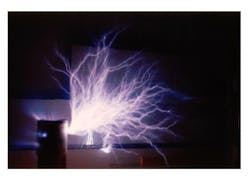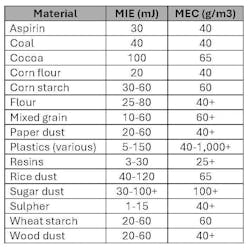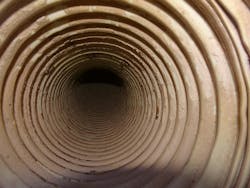The importance of Minimum Ignition Energy (MIE) and Minimum Explosive Concentration (MEC) in combustible dust explosivity testing
Any company that handles combustible dusts is required to complete a Dust Hazards Analysis (DHA). A critical part of the DHA is to test the material(s) to determine the explosivity characteristics of the dust or dusts. Too often, the testing stops after determining the Deflagration Index (Kst) and Maximum Explosion Pressure (Pmax) of the materials. Although Kst and Pmax are obviously important — mainly for determining explosion protection requirements — they do not begin to address the real, day-to-day, hazards and risks of handling the combustible dust in a facility. Unless the explosivity testing includes Minimum Ignition Energy (MIE) and Minimum Explosive Concentration (MEC), it is not possible to truly understand the hazards and risks involved in the processing and handling of the combustible dusts in a facility.
MIE and MEC basics
MIE is defined in NPFA 652 (2019 edition) as “The lowest capacitive spark energy capable of igniting the most ignition-sensitive concentration of a flammable vapor-air mixture or a combustible dust-air mixture as determined by a standard test procedure.” As usual, since definitions in any standard must seek to be all-inclusive, the description seems onerous. Simply put, where combustible dusts are involved, MIE represents the minimum energy required to ignite a cloud of that combustible dust. This does assume there is enough dust to ignite.
MEC is defined in NPFA 652 (2019 edition) as “The minimum concentration of a combustible dust suspended in air, measured in mass per unit volume, that will support a deflagration.” Keep in mind that the dust must be suspended in air and of a sufficient concentration to generate either an explosion or a flash fire.
MIE is measured in milli-Joules (mJ). To provide a perspective of the energy involved, a person can generate 10 to 30 mJ through various activities. With certain suspended combustible dusts, this level of energy is sufficient to create an explosion or flash fire. The typical test mechanism for MIE is shown in Figure 1.
MEC is measured in grams per cubic meter (or lbs./ounces/grains per cubic foot, for U.S. terms). Since a gram is only 0.0022 lbs. (approximate) even 100 grams would be a very small amount of material suspended in a full cubic meter (35.31 cubic feet). The test device for MEC is the same basic test device as that used for Kst and Pmax, but with different parameters (Figure 2).
MIE and MEC values of common materials
The MIE and MEC for combustible dusts vary considerably, even within a specific material. For example, there is no doubt that corn starch is explosive, but coarse corn starch can have MIE and MEC values many times higher and require stronger ignition sources than ultra-fine corn starch, which can be ignited by lower energy electrostatic discharges.
Table 1 provides examples of MIE and MEC values for some common combustible dusts.
Real-world examples demonstrating the importance of MIE and MEC
The following real-world examples illustrate how imperative it is to understand the MIE and MEC of combustible dusts and how these characteristics impact everyday operations.
Example 1: As part of a dust collection system, a company (unwisely) is using inexpensive and convoluted hose to connect a hood collecting significant amounts of resin dust into a dust collection system. Resin dusts typically have very low MIEs and MECs (high-risk range). It takes comparably little energy and airborne material loading to lead to a deflagration event.
The hose used in this example is commonly used for this type of application for multiple reasons. In this example, this is a significant mistake as it is impossible to effectively bond/ground this hose and dissipate any electrostatic charges generated by the airflow and combustible dusts passing through the hose. The minimum recommended velocity for dust collection where combustible dusts are involved is in the range of 4,000 fpm (though I recommend a minimum of 4,500 fpm).
At that velocity, especially with this material, this type of hose, and significant airborne dust loadings, it is very possible to generate propagating brush discharges (Figure 3).
Propagating brush discharges can produce an igniting energy in the 1,000-mJ range, which is sufficient to ignite most combustible dusts. Also, this type of electrostatic discharge is common in hoses used in this example due to lack of static dissipation and interior convolutions (as shown in Figure 4). Additionally, the resin’s low MIE and MEC makes the material more susceptible to ignition should sufficient fuel (dust) be available.
In this example, the creation of a propagating brush discharge can create an ember by igniting some of the particles passing through the hose. Those hot particles are then conveyed into a dust collector where a nearly perfect environment exists for a deflagration event.
Example 2: Company XYZ makes custom food products that require screening and delumping of the ingredients before they are blended. As part of this process, they use fine milk powder supplied in 50-lb. bags. This requires the employees to hand-dump the bagged powdered milk onto a vibrating screen deck that is equipped with poorly designed and ineffective dust collection (Figure 5).
Hand dumping bagged material is a dynamic process that creates clouds of dust, which are not being controlled by the screener’s ineffective dust collection. Unknown to Company XYZ, this combustible dust has an MIE of 20 mJ and an MEC in the range of 50 g/m3. During the dumping process, unknown to the operator, an electrostatic discharge occurs, igniting the cloud and creating a flash fire. The operator is fortunate to “only” receive first- and second-degree burns.
This is not an imaginary situation; it basically describes an actual event that could have been avoided by Company XYZ simply knowing that the dumped material could create such a situation.
The company contacted me after this event, and revisions were made to improve the dust collection (the absence of fuel controls the hazard), to effectively bond/ground the equipment, and to equip the operator with PPE.
Example 3: ABC Company does custom packaging for various products with MIE and MEC values ranging from very low to high. However, their dust collection system is poorly designed. The main equipment is inside and has no reasonable method to handle the collected material. Also, operators have to clean out the dust collector after each packaging run with a specific material.
Unfortunately, the “cleanout” process is done in a room with no dust collection, with multiple motor-driven equipment items, electrical controls, starters, etc. Additionally, the transfer of material is from plastic and metal custom barrels into a plastic open-topped tote. The result is shown in Figure 6.
ABC Company had no comprehension of the hazards and risks created by this scenario. With all the ignition sources in the area (some not shown in the figure) and the low-MIE and -MEC materials involved, the risk of ignition and flash fire was significant. The DHA made this clear to the company, and significant changes were made to mitigate the hazards and risks.
Example 4: Company AZ manufactures multiple types of metal stearates (such as magnesium stearate, zinc stearate, etc.). This class of material, unknown to Company AZ at the time, has very low MIE and MEC values (in this case the MIE was typically below 10 mJ and the MEC at 40 g/m3). Additionally, the materials and processes create significant dust clouds and accumulations on the surrounding surfaces.
To minimize operator and maintenance exposure to these chemicals, Company AZ required all employees to wear protective “coveralls” made mainly of polyethylene materials. The operators reported multiple “shocks” when working.
Company AZ had also experienced previous events and learned of this exposure during their DHA process.
The polyethylene material (like all “plastics”) acts as a capacitor and can result in arcing and “shocks” from the accumulation of electrostatic charges. The combination of very low MIE and MEC values and the work requirements created immediate hazards of flash fire exposures for the employees.
As a result, Company AZ changed to cotton uniforms and FR where needed (i.e., certain maintenance work, etc.). The “shock” incidents no longer occurred, significantly reducing hazard exposure for the employees (although additional improvements were also scheduled for completion).
These examples demonstrate the importance of testing for MIE and MEC explosivity characteristics. In a facility where higher risk materials are handled, companies must be made aware of how these characteristics affect everyday production processes and workers. Companies can avoid potential injuries and property damage by addressing these issues, but only if they understand the hazards and risks involved.
Jack Osborn ([email protected]) is a senior project engineer at Airdusco Engineering and Design Services and a member of Processing’s editorial advisory board. He has more than 47 years of experience in dust collection systems, centralized vacuum cleaning systems, pneumatic conveying systems, and all types of bulk handling systems and is a participating member of all six NFPA combustible dust committees (61, 484, 652, 654, 664, and Correlating).
Airdusco EDS
www.airdusco.com
About the Author

Jack Osborn
Senior Project Engineer
Jack Osborn is senior project engineer at Airdusco EDS and a member of Processing’s editorial advisory board. He has more than 50 years of experience in dust collection systems, centralized vacuum cleaning systems, pneumatic conveying systems, and all types of bulk handling systems. He has either designed or evaluated (e.g., engineering studies/audits, performance testing, etc.) more than 2,000 dust collection systems during his career and is a participating member of all six NFPA combustible dust committees.






